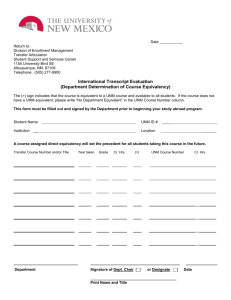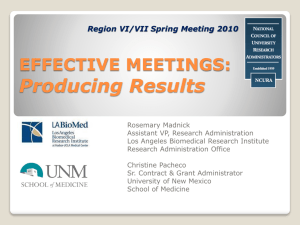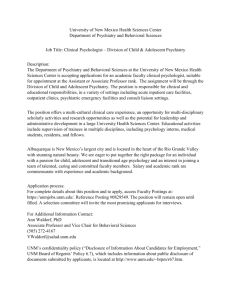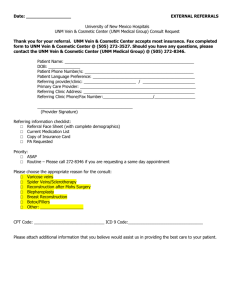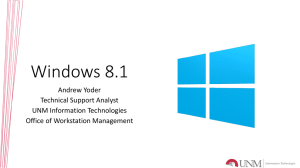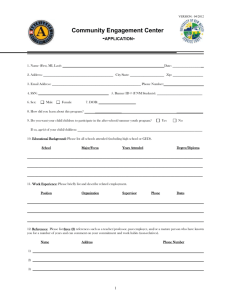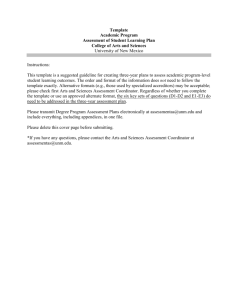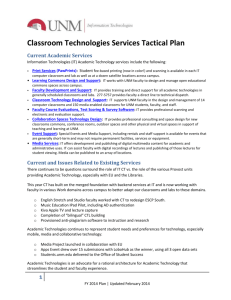PADM 525 Human Resource Management in the Public Sector
advertisement
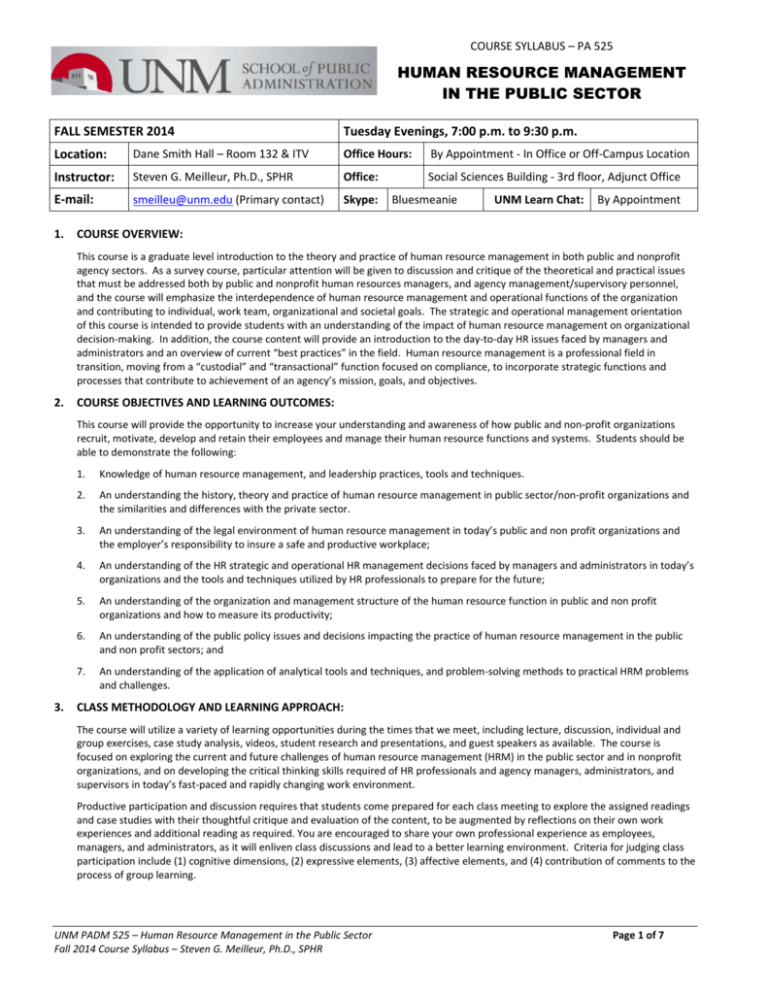
COURSE SYLLABUS – PA 525 HUMAN RESOURCE MANAGEMENT
IN THE PUBLIC SECTOR
FALL SEMESTER 2014 Tuesday Evenings, 7:00 p.m. to 9:30 p.m. Location: Dane Smith Hall – Room 132 & ITV Office Hours: By Appointment ‐ In Office or Off‐Campus Location Instructor: Steven G. Meilleur, Ph.D., SPHR Office: Social Sciences Building ‐ 3rd floor, Adjunct Office E‐mail: smeilleu@unm.edu (Primary contact) Skype: Bluesmeanie UNM Learn Chat: By Appointment 1.
COURSE OVERVIEW: This course is a graduate level introduction to the theory and practice of human resource management in both public and nonprofit agency sectors. As a survey course, particular attention will be given to discussion and critique of the theoretical and practical issues that must be addressed both by public and nonprofit human resources managers, and agency management/supervisory personnel, and the course will emphasize the interdependence of human resource management and operational functions of the organization and contributing to individual, work team, organizational and societal goals. The strategic and operational management orientation of this course is intended to provide students with an understanding of the impact of human resource management on organizational decision‐making. In addition, the course content will provide an introduction to the day‐to‐day HR issues faced by managers and administrators and an overview of current “best practices” in the field. Human resource management is a professional field in transition, moving from a “custodial” and “transactional” function focused on compliance, to incorporate strategic functions and processes that contribute to achievement of an agency’s mission, goals, and objectives. 2.
COURSE OBJECTIVES AND LEARNING OUTCOMES: This course will provide the opportunity to increase your understanding and awareness of how public and non‐profit organizations recruit, motivate, develop and retain their employees and manage their human resource functions and systems. Students should be able to demonstrate the following: 1.
Knowledge of human resource management, and leadership practices, tools and techniques. 2.
An understanding the history, theory and practice of human resource management in public sector/non‐profit organizations and the similarities and differences with the private sector. 3.
An understanding of the legal environment of human resource management in today’s public and non profit organizations and the employer’s responsibility to insure a safe and productive workplace; 4.
An understanding of the HR strategic and operational HR management decisions faced by managers and administrators in today’s organizations and the tools and techniques utilized by HR professionals to prepare for the future; 5.
An understanding of the organization and management structure of the human resource function in public and non profit organizations and how to measure its productivity; 6.
An understanding of the public policy issues and decisions impacting the practice of human resource management in the public and non profit sectors; and 7.
An understanding of the application of analytical tools and techniques, and problem‐solving methods to practical HRM problems and challenges. 3.
CLASS METHODOLOGY AND LEARNING APPROACH: The course will utilize a variety of learning opportunities during the times that we meet, including lecture, discussion, individual and group exercises, case study analysis, videos, student research and presentations, and guest speakers as available. The course is focused on exploring the current and future challenges of human resource management (HRM) in the public sector and in nonprofit organizations, and on developing the critical thinking skills required of HR professionals and agency managers, administrators, and supervisors in today’s fast‐paced and rapidly changing work environment. Productive participation and discussion requires that students come prepared for each class meeting to explore the assigned readings and case studies with their thoughtful critique and evaluation of the content, to be augmented by reflections on their own work experiences and additional reading as required. You are encouraged to share your own professional experience as employees, managers, and administrators, as it will enliven class discussions and lead to a better learning environment. Criteria for judging class participation include (1) cognitive dimensions, (2) expressive elements, (3) affective elements, and (4) contribution of comments to the process of group learning. UNM PADM 525 – Human Resource Management in the Public Sector Fall 2014 Course Syllabus – Steven G. Meilleur, Ph.D., SPHR Page 1 of 7 “Safe Space” Policy: Ground Rules for a Positive Classroom Environment and Experience For learning to occur when the class material is controversial, both tension and safety need to exist. There needs to be a safe classroom environment, so that students understand that they can speak their minds, and so that everyone feels comfortable and free to articulate ideas or viewpoints. Such a learning environment helps students to:
Develop their abilities to understand the perspectives of others; Develop mutual respect; Make a commitment to understand positions that they do not understand from the context or point of view of their peers; Take risks in speaking honestly in the class in the service of their learning. Expected class norms to enhance a safe learning environment include:
Students should respect confidentiality‐personal information or student comments should not get shared outside the classroom; Students should listen respectfully to different perspectives‐let people finish sentences before responding; Students should respond to what has been said, not the person saying it‐responses should not be personalized; Students should speak for themselves and not for others (including groups to which they belong); Students have the right to be silent in large group discussions. All classroom discourse will exhibit respect for all other persons, not only within the confines of the classroom but also in general. There will no denigration of anyone in any context (including in relation to case materials or readings, videos, or any other point of reference), on account of race, color religion, national origin, ethnicity, gender, disability status, genetic information, veteran status, sexual orientation, gender identity, religion, political perspective, any other trait that is protected under local, state or federal law. Class discussion allows for disagreement; however, comments must be sustained by evidence, in particular evidence from class materials and readings. Class comments are not to be unsupported assertions of opinion, and never ad hominem (personal) attacks. Incivility or rudeness of any kind is unacceptable. This includes carrying on conversations during class, checking cell phones or other electronic devices for messages, texting, and other distractions. The bottom line is this – my expectation is that you behave professionally at all times in class. 4.
COURSE MANAGEMENT: As a survey course, we will address new topics each session, endeavoring to understand their relationships as we discuss, analyze, and critique public administration theory and practice. I will utilize UNM Learn to post the course syllabus, course assignments, lecture notes, and discussions, as well as some email messaging. Primarily, students should use my regular UNM e‐mail account to communicate and send assignments electronically. DO NOT submit your papers to me via UNM Learn Mail. Finally, students will be able to access Supplemental Readings online at the class UNM Learn site. Please do not hesitate to contact me with your course questions or problems. In order to effectively manage this course, the following guidelines should be followed by students;
Students regularly attend class, are punctual, and prepared to discuss assigned course readings and exercises. Students are responsible for any missed readings, exercises, and assignments made or due during his/her absence. Students read for understanding the textbook chapters, supplemental readings, and exercises before class and actively participate in class discussions; consider the conceptual relationships among topics in the course content and the practical application of course material to public sector HR management. Students should regularly check the UNM Learn course homepage for updates, announcements, and new assignments. Students prepare all written assignments per instructions in the syllabus and submit them per the course schedule. 5.
COURSE SCHEDULE AND ASSIGNMENTS: NOTE: All reading assignments should be completed prior to class. It is solely the responsibility of the student to obtain notes, handouts, and summary of lesson/class activities, and to learn material from any missed class. Every written assignment must have compelling evidence of being proofread. See Graduate Writing Guidelines Rubric on UNM Learn Course Homepage. THIS SYLLABUS AND SCHEDULE IS SUBJECT TO REVISION AND SHOULD ALWAYS BE CONSIDERED TO BE IN DRAFT FORM. CONFIRM DEADLINES IN CLASS. DATE TOPICS, and ASSIGNMENTS READINGS 8/19/14 Course Introduction & Syllabus Review Human Resource Management (HRM) & Employment Law in the Public and Private Sectors Trends in Human Resource Management Additional Supplemental Readings and Pre‐Class assignments will be posted on the PADM 525 Homepage hosted by UNM Learn. Students should regularly check the PADM 525 Course Homepage before each class. 8/26/14
Berman – Chapter 1
Reeves – Case #30 Supplemental Materials – UNM Learn Course Homepage
The Public Service Heritage: Context, Continuity, and Change The Role of Human Resources in HRM Submit a 1 to 2‐page paper answering the discussion questions at the end of the Reeves case study. UNM PADM 525 – Human Resource Management in the Public Sector Fall 2014 Course Syllabus – Steven G. Meilleur, Ph.D., SPHR Page 2 of 7 9/2/14
Legal Rights and Responsibilities: Laws Governing the Workplace Berman – Chapter 2
Supplemental Materials – UNM Learn Course Homepage 9/9/14
Legal Rights and Responsibilities: Laws Governing the Workplace – Continued Submit a 1 to 2‐page paper answering the discussion questions at the end of the Reeves case study. See above.
Reeves – Case # 16 or Case #5 The Leadership Challenge: The Role of Managers and Supervisors in HRM Applied Research HRM Project Proposal Due Supplemental Materials – UNM Learn Course Homepage
9/16/14
9/23/14
Leadership and Team Effectiveness: Improving Team and Group Performance and Productivity Supplemental Materials – UNM Learn Course Homepage
9/30/14
Motivation: Possible, Probable, or Impossible? Employee Motivation – Theory and Practice Leadership Self‐Assessment and Development Plan Paper Due Berman – Chapter 6
Supplemental Materials – UNM Learn Course Homepage 10/14/14
Strategic Workforce Planning Employee Recruitment, Selection, and Placement Submit a 1 to 2‐page paper answering the discussion questions at the end of the Reeves case study. Berman – Chapters 3 and 4
Reeves – Case #1 Supplemental Materials – UNM Learn Course Homepage 10/21/14
Position Management – Job Design, Classification, and Organizational Design Employee Compensation: Total Compensation, Pay and Benefits Berman – Chapters 5 and 7
Supplemental Materials – UNM Learn Course Homepage
10/28/14 Employment Policies, Procedures, and Guidelines Employee‐Friendly Policies Submit a 1 to 2‐page paper answering the discussion questions at the end of the Reeves case study. Berman – Chapter 8
Reeves ‐ Case #6 Supplemental Materials – UNM Learn Course Homepage 11/4/14
Strategic Human Resource Development Training, Learning and Development Berman – Chapter 9
Supplemental Materials – UNM Learn Course Homepage 11/11/14
Strategic HRD, Training & Development Continued Berman – Chapter 9
Supplemental Materials – UNM Learn Course Homepage Group Case Analysis Due – In Class Discussion of Case 11/18/14
Performance Management & Appraisal Coaching and Counseling for Performance Submit a 1 to 2‐page paper answering the discussion questions at the end of the Reeves case study. 11/25/14
Have a nice Thanksgiving break 12/2/14
Managing Performance Problems, Discipline and Discharge Supplemental Materials – UNM Learn Course Homepage
12/9/14
Unions & the Government: Labor Relations in the Public Sector, Collective Bargaining New Mexico Public Employees Bargaining Act Applied Research HRM Project Paper Due Berman – Chapters 11 & 12, Conclusion Reeves – Case #9 and Case #11 – in class discussion Supplemental Materials – UNM Learn Course Homepage
Final Exam Period ‐ No In‐Class Final Exam Berman – Chapter 10
Reeves – Case #19 Supplemental Materials – UNM Learn Course Homepage 6.
REQUIRED TEXT AND MATERIALS
Berman, Evan et.al. (2010) Human Resources Management in the Public Service: Paradoxes, Processes, and Problems, 4th Edition, Thousand Oaks, CA: Sage Publications. Reeves, T. Zane (2006) Cases in Public Human Resource Management, 2nd Edition, Belmont, CA: Thomson/Wadsworth Articles, research reports, and supplemental handout materials provided on‐line through UNM Learn UNM PADM 525 – Human Resource Management in the Public Sector Fall 2014 Course Syllabus – Steven G. Meilleur, Ph.D., SPHR Page 3 of 7 7.
GRADING AND COURSE REQUIREMENTS / DELIVERABLES: Course Requirements – See Assignment Guidelines Below
% of Grade
Grading Scale
1.
2.
3.
4.
5.
6.
Case Study Short Papers (From Reeves book) – 6 Cases @ 5% each 25% 98% to 100% A+ Applied Research HRM Project Proposal 5% 94% to 97.9% A Leadership Self‐Assessment and Development Plan 15% 90% to 93.9% ‐A Urbanopolis Case Analysis Paper 20% 87% to 89.9% B+ Applied Research HRM Project Paper & Discussion 30% 84% to 86.9% B Participation in Class (includes attendance) 5% 80% to 83.9% ‐B 75% to 79.9% C Below 75% F INCOMPLETE POLICY Students are expected to behave in a professional manner and to turn in all materials at the designated time. In accordance with university regulations, a grade of “Incomplete” will only be given when the quality of work is satisfactory but a minor yet essential requirement of the course has not been completed for reasons acceptable to the instructor. Requests for a grade of “I” must be submitted in writing to the instructor no later than the date of the last class session of the term. Such requests must include a proposed timeline for submitting the work required for completing the course, and you will be required to adhere to that timeline once it is agreed to by the instructor. Failure to do so may result in a grade of “F” for the course. WRITING QUALITY This is a writing intensive course. Although I am far more concerned about substance than form, please keep in mind that this is, after all, a professional, graduate level course. All of your written assignments should be prepared with the attention due to a professional presentation, and expected from a Master’s degree candidate. Yes, this means grammar and punctuation, too. Written assignments require proofreading and editing prior to submission, with attention to correct grammar, spelling, punctuation, paragraphs, and sentence structure. (See the Purdue University OWL site {link on UNM Learn course homepage} for further assistance). NOTE that writing competency is extremely important in graduate school, as well as in your professional career. The grade penalty is significant for lack of simple proofing of grammar and spelling on all assignments, and for a lack of attention to professional writing and presentation of your paper. As a graduate student and a current and/or aspiring leader in public administration, you have a responsibility to the profession and those you will be representing to write professionally. It is wise to have a friend serve as an editor to proofread your written assignments. If you struggle with writing, I strongly encourage you to use the services of The University of New Mexico Center for Academic Program Support (CAPS). CAPS provides a variety of writing resources for graduate students (see http://caps.unm.edu/writing). The OGS Graduate Resource Center (GRC) also provides dedicated services available for any graduate or professional student engaged in most writing and research projects. The URL for that website is http://caps.unm.edu/writing/grad. Take this task seriously and consult the University of New Mexico OGS Graduate Resource Center (GRC) for assistance – the investment of time will pay off for you in the future. FORM OF WRITTEN PAPERS AND APA STYLE All papers are required to follow current APA Style Format. Please submit all written papers via my UNM e‐mail account to me, in MS Word format. DO NOT submit your papers to me via UNM Learn Mail. I will provide feedback to you on your written work using the MS‐Word “Comments” function. Please let me know in advance if you use a word processor other than MS Word – in that case, you will probably need to submit your papers in RTF format. I have included an annotated sample APA Style paper for reference on the UNM Learn course homepage. My favorite website for APA Style is the Purdue University OWL site; I have included the url for this excellent website on the UNM Learn Course Homepage. The Purdue OWL site also has excellent resources to improve your writing, as well as and reference material on conducting basic primary and secondary research. For further guidelines, refer to Publication Manual of the American Psychological Association, Current Edition. The APA Manual provides answers to all level of detail regarding citations of references, grammar, and other related issues. The APA is a widely held standard for manuscripts in the social sciences, including Public Administration, and is a frequent standard for graduate‐level writing.
THIS IS IMPORTANT! All written assignments submitted electronically need to follow this naming convention for your document file that you submit electronically: LAST NAME, FIRST INITIAL, ASSIGNMENT TITLE, PA525. For example: Smith_J_Current HR Issues_PA525. DO NOT MAKE THE TITLE TOO LONG !!!
Proper reference sources MUST be cited for your outside reference materials. Proper academic reference sources include primary and secondary research, journal articles (refereed, juried, or peer reviewed), professional and trade journals, abstracts, research reports and dissertations. Wikipedia is NOT a legitimate academic reference.
NOTE: Paper length guidelines do NOT include your title page, abstract page, bibliography of references, or appendices. The guidelines refer to the length of the body of the paper. UNM PADM 525 – Human Resource Management in the Public Sector Fall 2014 Course Syllabus – Steven G. Meilleur, Ph.D., SPHR Page 4 of 7 1. Case Study Short Papers (From Reeves book) – 6 Cases @ 5% each You are to submit a total of six (6) 2‐page papers for each of the assigned case studies in the Reeves casebook, answering the discussion questions at the end of each case study. The Reeves casebook will also be used for classroom discussion to illustrate and apply theoretical concepts and models of human resource management. Please read and prepare your papers on the cases listed in the “Readings” section of this syllabus. Complete assigned case studies by the dates in the syllabus. You should also be prepared to discuss these cases in class. Late papers will not be accepted; students who are absent with prior excused absences from class will be expected to send papers by e‐mail. Use APA Style (Title page, headers, References, proper format of the narrative. An abstract is not necessary for these case study papers. Each case analysis need be no more than two (2) pages. A minimum of two (2) outside reference sources must be used and properly cited in APA style. 2. Applied Research HRM Project Proposal The purpose of this Applied Research HRM Project Proposal is for you to start working on your Applied Research Project Paper (see #5 below). You are to prepare and submit a proposal for your applied research, which is to be a practical, applied look at a human resource management issue in the workplace (your own, or another organization). The goal of the proposal is to set the scope of the project and to ensure that work on the project begins as early as possible. The proposal also gives the instructor an opportunity to provide feedback on the project’s merits. For this proposal, you will write down your preliminary ideas for the organization you will use as a case analysis for your final project. Your proposal paper should include the following:
a definition of the problems/issues of concern, or opportunity for improvement – sources and consequences, persons and organizational units affected, and whether the problem is one of inefficiency, ineffectiveness, and/or inequity; a statement of purpose framed as a research question and sub‐questions, the importance of the topic, and initial listing of primary and secondary sources for your research; the background of the problem(s), drawn from personal knowledge and perhaps an interview with a knowledgeable person (document the interview in the text of the paper following proper current APA Style – see sample paper provided on the UNM Learn Course homepage folder, for proper citation of interviews). Use APA Style. The proposal need be no more than four (4) pages. A minimum of two (2) outside reference sources must be used and properly cited in APA style. 3. Leadership Self‐Assessment and Development Plan For this assignment you are to complete a Leadership self‐assessment and development plan for yourself, based on the “Leadership Development Plan Guidelines” and the “Best Leader Exercise” both of which are found in the Leadership Class folder on the Learn Course Homepage, and which are based on Kouzes and Posner's acclaimed Five Practices of Exemplary Leadership®. You should use the data from these plus other materials from the course to prepare a leadership self‐assessment and development plan. Include a discussion of what you have learned about leadership, and how that knowledge has impacted your understanding of effective human resource management. For the paper, use outside references and other leadership models as appropriate, and you should include the completed self‐assessment as an attachment to your paper. It is expected that you will begin to implement your development plan during the course and continue with it after the course ends. Use APA Style. The paper should be no more six (six) pages. A minimum of three (3) outside reference sources must be used and properly cited in APA style. 4. Group/Team Case Analysis Paper The purpose of the Case Analysis Paper is to apply the theory and concepts from the seminar to a practical, applied case assigned by the instructor. This case analysis should be done in teams of between 2 to 4 students. To analyze a case, you critically examine the organizational and employee issues confronted in the case. Most often you will need to read the case several times ‐ once to grasp the overall picture of the situation and then to discover and understand the specific problems, dynamics, and work environment from the case. The case analysis requirements are as follows:
Develop a brief overview of the case that summarizes the situation, HR issues, and dynamics between employee and employer and the history of their relationship. Analyze the case based on HR & management theory and practice as presented in the textbook, lectures, supplemental readings, and other outside reference sources with a focus on how the case helps us better understand human resource management functions and processes in public and nonprofit organizations. Apply the concepts, tools and methods to the case that are covered by Berman and authors from the supplemental readings based on class lectures and discussions, and personal experience. Recommend a course of action to address the problems and/or issues presented in the case. Use APA Style. In no more than eighteen (18) pages, support your analysis with material from the text and other outside reference sources. A minimum of six (6) outside reference sources must be used and properly cited in APA style. 5. Applied Research HRM Project Paper & Discussion The purpose of the Applied Research HRM Project Paper is to complete a comparative case analysis of your chosen organization against the topics outlined in the text and other supplemental materials from the course. You are to seek information on human relations, leadership styles, how the organization handles various human resource management functions, organizational change, UNM PADM 525 – Human Resource Management in the Public Sector Fall 2014 Course Syllabus – Steven G. Meilleur, Ph.D., SPHR Page 5 of 7 conflict, and other challenges. Once the analysis is complete, you will make recommendations on how to improve performance, productivity, efficiency, motivation, and addresses issues related to employee engagement and other human resource management issues. Reviewing the Table of Contents of the text and the course topics outline should provide an easy framework from which to assess your organization and conduct your research and analysis. You should seek opportunities to interview the organization’s senior management or Human Resource Director. Interviews may be conducted via telephone, face to face or by e‐mail. Your research and analysis of the human resource management problem(s) you are investigating should reflect both the theoretical and practical dimensions of the issues, with the objective of increasing your understanding of the impact of the issue on the practice of human resource management in public and non‐profit organizations. The paper may draw on content from throughout the course, using journal articles, books, and primary research data to demonstrate your understanding of the issue. The minimum research paper requirements are as follows:
Review the relevant literature found in professional and trade journals, abstracts, research reports and dissertations and discuss the differences and similarities in the various points of view about your topic; at least three refereed research journal sources are required in addition to other library or internet sources. Based on your research, discuss the practical application of your research topic to better understand the theory and practice of public administration. Discuss the conclusions from your research that respond to your research question and your recommendations for improving the practice of public administration and/or public policymaking. Use APA Style. In no more than twelve (12) pages, support your analysis with material from the text and other outside reference sources. A minimum of six (6) outside reference sources must be used and properly cited in APA style. 6. Course Participation Ongoing student participation is encouraged and will be assessed as apart of the total course grade. Participation is reflected by course attendance, presentations, and contributions to discussions, particularly in analyzing and critiquing assigned readings and cases. The student’s contribution to course discussions will be assessed in terms of the quantity and quality of the contribution, demonstrating critical thinking and analysis skills as opposed to the number of times a student speaks up in class. Therefore, it is important for students to be prepared for course discussions and presentations. 8.
POLICY STATEMENTS: UNIVERSITY AND COURSE POLICIES University policies are provided in the current course catalog and course schedules. They are also available on the university website. This class is governed by the university’s published policies. The following policies are of particular interest: Academic Honesty The University is committed to high standards of academic honesty. Students will be held responsible for violations of these standards. Please refer to the university’s academic honesty policies for a definition of academic dishonesty and potential disciplinary actions associated with it. In preparing written assignments, students need to be aware of the UNM Student Code of Conduct governing academic dishonesty, particularly plagiarism (see below). It is a violation University policy to claim credit for work not done or done by others, or misrepresenting the work as your own. There are numerous sources available through the UNM website to help you better understand the rules. (See the Pathfinder, Student Code of Conduct, 2.4.) Plagiarism It is often an unintentional mistake, but plagiarism continues to be a problem given our easy access to the internet and the availability of tools to copy and paste to your computer. It is even more problematic to paraphrase the work of another author and not acknowledge the source. If you are unsure, cite the source and avoid any suggestion of plagiarism. Recognize that any wording presented in a paper without quotation marks or other citation is considered to be your own work. Students who are discovered cheating or committing plagiarism will be awarded a failing grade for the course and may be subject to dismissal from the SPA program or other further discipline. Assignments and/or research projects may, at the instructor's discretion, be submitted to one of several online services that search for plagiarism from the World Wide Web and from various term paper companies that sell term papers via the World Wide Web. Students who are discovered cheating or committing plagiarism may be awarded a failing grade for the course and may be subject to dismissal or further discipline by the university. Assignments and/or research projects may, at the instructor's discretion, be submitted to one of several online services that search for plagiarism from the World Wide Web and from various term paper companies that sell term papers via the World Wide Web. All citations must conform to current APA Style Guidelines (See Drops and Withdrawals In the event that you choose to drop or withdraw from the course, it is YOUR responsibility, not the instructor’s. Please be aware that, should you choose to drop or withdraw from this course, the date on which you notify UNM of your decision will determine the amount of tuition refund you receive. Please refer to the university policies on drops and withdrawals (published elsewhere) to find out what the deadlines are for dropping a course with a full refund and for withdrawing from a course with a partial refund. UNM PADM 525 – Human Resource Management in the Public Sector Fall 2014 Course Syllabus – Steven G. Meilleur, Ph.D., SPHR Page 6 of 7 Disturbances Since every student is entitled to full participation in class without interruption, disruption of class by inconsiderate behavior is not acceptable. Students are expected to treat the instructor and other students with dignity and respect, especially in cases where a diversity of opinion arises. Students who engage in disruptive behavior are subject to disciplinary action, including removal from the classroom and/or course. Class Attendance Policy Students are expected to attend all class sessions, and full participation in the class is expected. In the case of unavoidable absences, the student must contact the instructor in advance. The student is subject to appropriate academic penalty for incomplete or unacceptable makeup work or for excessive or unexcused absences. It is the student’s responsibility to secure all missed work and assignments. Students who are unable to complete course requirements because of illness or other justifiable circumstances may be allowed to take an incomplete grade in those cases where a major portion of the work (generally, more than 75%) has been successfully completed. Accommodations Anyone requiring special accommodation or assistive technology is asked to advise Dr. Meilleur within the first two weeks of class, so that reasonable accommodation may be provided through the University. The School of Public Administration is committed to providing all necessary and feasible accommodation to students with disabilities so that they may fully participate in and contribute to their classes. Confidentiality will be maintained as indicated by the student’s circumstances. 9.
OTHER INFORMATION: Instructor Guidance: I will be happy to review your written work in progress at any time. You’d be amazed at how few people take advantage of this opportunity. Generally I will have my comments back to you within a day or two, barring unforeseen circumstances. You are bound to run into problems with your projects along the way. I am happy to consult with you about your projects if you have questions, concerns, roadblocks, or if you just need a sounding board. Please contact me to set up these consultations by appointment, or during office hours. Again, you’d be surprised at how few people take me up on this offer. Please feel free to contact me at any time if you have questions or concerns about the course. Syllabus Modification: The instructor reserves the right to change the class schedule, course requirements, or grading criteria based on changing circumstances and events, University policies, material deemed helpful for your individual projects, and/or class input. 10. INSTRUCTOR BACKGROUND: Steven G. Meilleur, Ph.D., SPHR has more than 38 years of professional experience in human resources management in the public, private non‐profit and private for‐profit sectors. Currently, Dr. Meilleur is Senior Vice‐President, and Risk Services Consultant for Human Resources and Employment with Poms & Associates, a national risk services and insurance brokerage firm that provides risk management training, consulting and information services, and insurance services for its clients and other businesses and organizations. He previously worked as Vice President of Human Resources and Risk Management with Adelante Development Center in Albuquerque, a $26.5 million non‐profit organization with over 900 employees, where he was responsible for all human resources, human resource development & organizational development, and risk management functions for the agency. Dr. Meilleur has also served as Director of Human Resources for the City of Rio Rancho, NM, Human Resources Team Leader and Manager of Organizational Learning with Plains Electric G&T Cooperative, Director of the State Bar of New Mexico’s Center for Legal Education. He is faculty member at the UNM School of Public Administration, holding the position of Visiting Lecturer III and teaching in the areas of human resource management, employment and labor relations, dispute resolution, organizational change, and human resource development. He has also been on the faculty at Webster University in the graduate studies programs since 1994. He has spoken at numerous conferences and workshops across the country, and is a published author in the areas of human resources, leadership and management development, organizational change and innovation, non‐profit organization management, and board development. Dr. Meilleur received a BA in English Literature and Education from Bucknell University, an Executive MBA from the University of New Mexico, and his Ph.D. in Leadership and Organizational Learning from UNM. He received his certification as a Senior Professional in Human Resources (SPHR) by the Society for Human Resource Management in 1995. 11. FINAL REMARKS FROM DR. MEILLEUR The more you put into this class, the more you will take from it. Reviewing scholarly work, pondering concepts, and making sense of theory in practice can be painful and time‐consuming. I understand this! There will be times when your brain hurts. That’s a good thing. Take it as a sign that some good learning is going on. In fact, good learning is often confusing and uncomfortable before it becomes fun. If you keep up with readings, actively engage in class dialogues and activities, and constantly seeking feedback and advice from your colleagues and course instructor, you should have a rewarding experience in this course. UNM PADM 525 – Human Resource Management in the Public Sector Fall 2014 Course Syllabus – Steven G. Meilleur, Ph.D., SPHR Page 7 of 7
